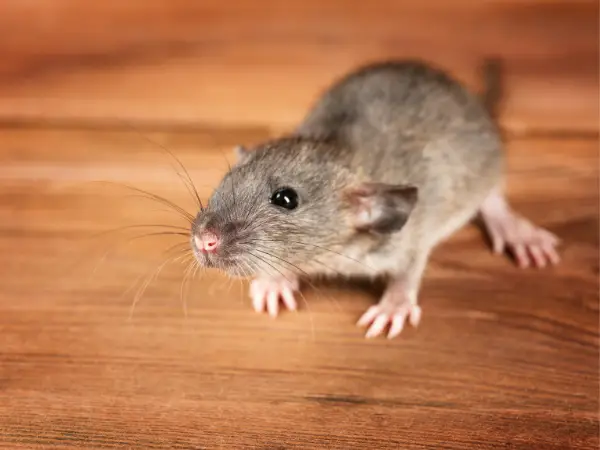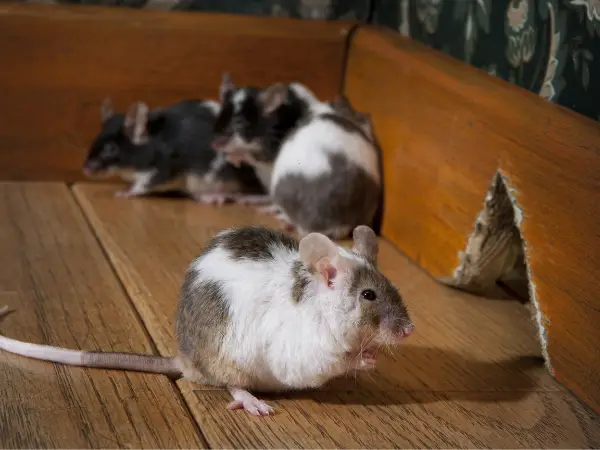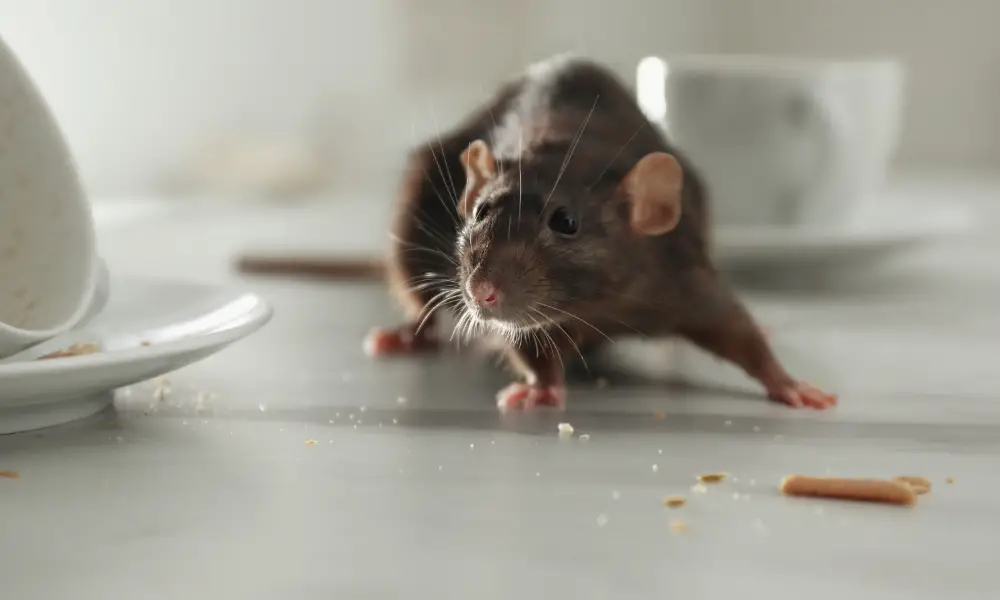Mice might come near you while you sleep if there is food or clutter in your bedroom. They are nocturnal and seek warmth and food.
Mice are small, nocturnal rodents that can invade homes in search of food and shelter. These creatures are often attracted to areas with food crumbs, clutter, or warmth. Bedrooms, especially those with snacks or poor cleanliness, can become inviting places for mice.
Mice Behavior At Night
Many people worry about mice coming near them while they sleep. Understanding mice behavior at night can help ease these concerns. Mice are small, nocturnal creatures that are active after dark.
Nocturnal Nature
Mice are primarily nocturnal, meaning they are most active during the night. This behavior helps them avoid predators and humans. During the day, mice tend to hide in dark, secluded areas like walls, attics, or basements. Once night falls, they come out to search for food and water.
Here are some key points about their nocturnal nature:
- Peak Activity Hours: Mice are most active between dusk and dawn.
- Quiet Explorers: Mice move quietly to avoid detection. They have excellent hearing and can sense vibrations.
- Light Sensitivity: Bright lights deter mice. They prefer dimly lit or dark environments.
Understanding these behaviors can help you take steps to deter mice. For example, keeping lights on in areas where you suspect mice activity can make these areas less appealing to them.
Here’s a simple table to summarize their nocturnal nature:
| Behavior | Details |
|---|---|
| Active Hours | Dusk to Dawn |
| Movement | Quiet and Stealthy |
| Light Preference | Dim or Dark Environments |
Foraging Habits
Mice are constantly on the hunt for food and water during the night. Their small size allows them to squeeze into tiny spaces, making it easy for them to explore homes. Mice have a very keen sense of smell, which they use to locate food sources.
Here are some insights into their foraging habits:
- Food Preferences: Mice eat grains, fruits, seeds, and even small insects.
- Water Sources: They need very little water and can get moisture from their food.
- Pathways: Mice follow the same paths every night. They leave behind droppings and urine, which help them navigate.
To make your home less attractive to mice, store food in airtight containers and clean up crumbs and spills promptly. Sealing entry points like cracks and holes can also prevent them from getting inside.
Here’s a breakdown of their foraging habits:
| Foraging Aspect | Details |
|---|---|
| Diet | Grains, Fruits, Seeds, Small Insects |
| Water Needs | Minimal, from Food |
| Navigation | Same Paths, Droppings, Urine Trails |
Factors Attracting Mice
Mice are drawn to specific elements in your home, and knowing these can help you keep them at bay.
Food Sources
Mice are always on the hunt for food. Food scraps and crumbs left around your home can be a major attraction for them. These tiny creatures can smell food from a distance and will follow their noses to the source. Even small pieces of food left out can be enough to draw them in.
- Uncovered trash cans: Mice can easily access trash cans that are not properly sealed. Make sure your trash cans have tight-fitting lids.
- Pet food: If you leave pet food out overnight, mice might come to snack on it. Store pet food in sealed containers.
- Food spills: Clean up any food spills immediately. Even small crumbs can attract mice.
Proper food storage is essential. Use airtight containers to store food items such as cereals, grains, and other dry goods. This not only keeps the food fresh but also prevents mice from detecting the scent.
Consider the following table for a quick reference on food storage tips:
| Food Item | Storage Method |
|---|---|
| Cereal | Airtight container |
| Grains | Sealed bags or containers |
| Pet food | Sealed containers |
By keeping your home clean and storing food properly, you can reduce the chances of mice coming near you while you sleep.
Shelter Needs
Mice need a warm, safe place to live, and your home can offer the perfect shelter. They look for small, hidden spaces to build their nests. Understanding what attracts mice to certain shelters can help you make your home less inviting for them.
Clutter and debris provide excellent hiding spots for mice. They can nest in piles of paper, clothing, or other items that are left undisturbed. Keeping your home tidy can help deter mice.
- Cardboard boxes: Mice can chew through cardboard easily. Use plastic storage bins instead.
- Attics and basements: These areas often go unused and can become prime nesting spots. Regularly clean and inspect these spaces.
- Wall voids and gaps: Mice can squeeze through tiny openings. Seal any gaps or cracks in your walls, floors, and foundations.
Regular maintenance of your home can also help keep mice away. Check for any signs of mice, such as droppings or gnawed materials, and address the issue immediately.
Here is a quick checklist to make your home less inviting for mice:
- Seal all gaps and cracks.
- Use plastic storage bins instead of cardboard boxes.
- Keep attics and basements clean and clutter-free.
- Store food in airtight containers.
By addressing these shelter needs, you can make your home less attractive to mice and reduce the risk of them coming near you while you sleep.

Signs Of Mouse Presence
Identifying the signs of mouse presence is crucial to keep them out of your bedroom.
Droppings And Tracks
Mice leave behind small, dark droppings that resemble tiny grains of rice. These droppings are often found in areas where mice are active. Look for them along baseboards, inside cabinets, and near food sources. Here are some key points:
- Size: Mice droppings are about 1/4 inch long.
- Shape: They have pointed ends.
- Quantity: You may find several droppings in one spot.
Besides droppings, mice leave tracks. You might see tiny footprints in dusty areas or smudge marks along walls. Mice have oily fur, which leaves dark streaks where they frequently travel. To identify tracks, sprinkle some flour or baby powder on suspected paths and check for footprints the next day.
| Sign | Description |
|---|---|
| Droppings | Small, dark, rice-sized with pointed ends |
| Tracks | Footprints in dust or powder, smudge marks on walls |
Nesting Materials
Mice create nests using soft materials. They prefer hidden spots near food sources. Common nesting materials include:
- Paper: Torn bits of newspaper or cardboard.
- Fabric: Shredded cloth or upholstery stuffing.
- Plant matter: Leaves, grass, or twigs.
Finding these materials in corners, drawers, or other secluded spots indicates a mouse nest. Mice build nests to stay warm and raise their young, so nests are usually well-hidden. To locate nests, check behind appliances, inside closets, and under furniture.
Inspect these areas regularly to spot signs of nesting materials. If you find nests, act quickly to remove them and address the mouse problem. Mice reproduce rapidly, so early detection is key to preventing an infestation.
Sleeping Conditions
Your sleeping conditions play a major role in attracting or deterring these tiny invaders.
Room Environment
The environment in your room can either invite or repel mice. To make your room less attractive to mice, consider these factors:
- Temperature: Mice love warm and cozy places. Keeping your room cool can make it less inviting.
- Humidity: Mice need moisture. Using a dehumidifier can keep the air dry and less appealing to them.
- Lighting: Mice are nocturnal. Keeping a night light on can discourage them from entering your space.
Here’s a quick look at how these factors influence mice behavior:
| Factor | Effect on Mice |
|---|---|
| Warm Temperature | Attracts Mice |
| Cool Temperature | Repels Mice |
| High Humidity | Attracts Mice |
| Low Humidity | Repels Mice |
| Darkness | Attracts Mice |
| Light | Repels Mice |
Clutter Levels
Clutter provides perfect hiding spots for mice. Keeping your room tidy can make a huge difference. Here are some tips to reduce clutter:
- Regular Cleaning: Vacuum and dust your room weekly to remove crumbs and food particles.
- Organize Belongings: Store items in closed containers to eliminate hiding spots.
- Dispose of Trash: Empty your trash bin daily to avoid attracting mice.
To better understand how clutter influences mice presence, consider the following:
- Under the Bed: Keep this area clear. Mice love dark and cluttered spaces.
- Closets: Organize and clean regularly. Mice can nest in piles of clothes.
- Furniture: Move and clean behind furniture. Dust and crumbs can attract mice.
Here’s a simple table to illustrate the impact of clutter:
| Clutter Area | Effect on Mice |
|---|---|
| Under the Bed | Attracts Mice |
| Messy Closets | Attracts Mice |
| Behind Furniture | Attracts Mice |
| Organized Space | Repels Mice |
By maintaining a cool, dry, and well-lit room, and keeping clutter to a minimum, you can create an environment that mice will want to avoid.

Health Risks From Mice
Mice do not just invade your space; they also bring significant health risks. Knowing these risks can help you understand why keeping mice away is crucial.
Disease Transmission
Mice can carry and transmit many diseases. These diseases can spread to humans through direct contact or contaminated food. Here are some key diseases transmitted by mice:
- Hantavirus: This virus is found in rodent urine, droppings, and saliva. It can cause severe respiratory issues.
- Salmonella: Mice can contaminate food with their droppings. This bacteria causes food poisoning, leading to stomach pain, diarrhea, and fever.
- Leptospirosis: This bacterial infection spreads through water contaminated with mouse urine. It can lead to kidney damage, liver failure, and even death.
Consider the table below for a quick overview of diseases transmitted by mice:
| Disease | Transmission Method | Symptoms |
|---|---|---|
| Hantavirus | Urine, Droppings, Saliva | Fever, Muscle Aches, Respiratory Issues |
| Salmonella | Contaminated Food | Stomach Pain, Diarrhea, Fever |
| Leptospirosis | Contaminated Water | Fever, Headache, Kidney Damage |
Allergies And Asthma
Mice can also trigger allergies and asthma. Their droppings, urine, and dander can be powerful allergens. Here are some ways mice can affect your health:
- Allergic Reactions: Mouse allergens can cause sneezing, itchy eyes, and skin rashes. These reactions can be very uncomfortable.
- Asthma Attacks: People with asthma are at higher risk. Mouse droppings and urine can trigger severe asthma attacks.
To help you understand better, check the symptoms and triggers below:
| Health Issue | Trigger | Symptoms |
|---|---|---|
| Allergies | Droppings, Urine, Dander | Sneezing, Itchy Eyes, Skin Rashes |
| Asthma | Droppings, Urine | Wheezing, Shortness of Breath, Chest Tightness |
Keeping your home mouse-free is essential for your health. Regular cleaning and sealing entry points can help reduce these risks.
Preventing Mouse Encounters
Mice are small, curious creatures that often seek out warm, quiet places to nest. Preventing mouse encounters in your home is crucial for peace of mind and health. Here are some effective ways to keep these tiny intruders at bay.
Sealing Entry Points
Mice can squeeze through tiny openings. Sealing entry points is one of the most effective ways to keep them out. Inspect your home for any gaps or holes. Common entry points include:
- Cracks in walls
- Gaps around windows and doors
- Spaces around utility pipes
- Vents and chimneys
Use materials like steel wool, caulk, or metal mesh to block these entry points. Weather stripping can be added around doors and windows to further prevent access. Here’s a quick table for the materials needed:
| Material | Use |
|---|---|
| Steel Wool | Filling small holes |
| Caulk | Sealing gaps |
| Metal Mesh | Covering larger openings |
| Weather Stripping | Sealing doors and windows |
Regularly inspect your home for new gaps or holes. This proactive approach ensures your home remains mouse-free.
Proper Food Storage
Mice are always on the hunt for food. Proper food storage is key to preventing them from entering your home. Follow these tips to keep food out of reach:
- Store food in airtight containers
- Keep counters and floors clean and crumb-free
- Dispose of garbage regularly
- Store pet food in sealed containers
Here’s a checklist for proper food storage:
- Use glass or thick plastic containers
- Sweep and mop kitchen floors daily
- Wipe down kitchen counters after each meal
- Take out the trash every evening
By keeping food inaccessible and your home clean, you reduce the chances of attracting mice. Don’t leave food out overnight, and make sure all food is sealed and stored properly. This simple routine can make a big difference.
What To Do If You See A Mouse
Discovering a mouse in your home can be unsettling. Knowing what to do if you see a mouse is crucial. This guide will help you take immediate actions and implement long-term solutions to keep your home mouse-free.
Immediate Actions
If you spot a mouse, act quickly to prevent an infestation. Follow these steps:
- Stay calm: Mice are more scared of you than you are of them.
- Trap the mouse: Use a humane trap to catch it. Place some bait, like peanut butter, inside the trap.
- Seal the area: Close off the room where you saw the mouse to prevent it from escaping to other parts of your home.
- Clean up: Mice are attracted to food crumbs and spills. Clean up any food residues immediately.
Here’s a quick reference table for immediate actions:
| Action | Description |
|---|---|
| Stay calm | Mice are more scared of you |
| Trap the mouse | Use a humane trap with bait |
| Seal the area | Close off the room |
| Clean up | Remove food crumbs and spills |
These steps help manage the immediate threat of a mouse in your home. Next, consider long-term solutions to prevent future occurrences.
Long-term Solutions
Implementing long-term solutions ensures mice stay out of your home. Consider the following strategies:
- Seal entry points: Mice can enter through small holes. Inspect and seal gaps around doors, windows, and walls.
- Store food properly: Keep food in airtight containers. Avoid leaving food out in the open.
- Maintain cleanliness: Regularly clean your home. Dispose of garbage promptly.
- Use repellents: Natural repellents like peppermint oil can deter mice. Place cotton balls soaked in peppermint oil in areas where mice might enter.
Here’s a summary table for long-term solutions:
| Solution | Description |
|---|---|
| Seal entry points | Inspect and seal gaps |
| Store food properly | Use airtight containers |
| Maintain cleanliness | Regular cleaning and prompt garbage disposal |
| Use repellents | Peppermint oil as a natural deterrent |
By following these long-term strategies, you can effectively keep mice out and ensure your home remains a safe and comfortable place.
Common Myths About Mice
Mice are small creatures that often cause big worries. One common question is, “Will mice come near me while I sleep?” Many myths surround these tiny invaders, making it hard to know the truth. Let’s debunk some common myths about mice.
Mice And Cleanliness
Many people believe that mice only invade dirty homes. This is far from the truth. Mice are opportunistic creatures. They look for food, water, and shelter, regardless of how clean your home is. Here are some key points:
- Mice can enter clean homes. They are drawn to warmth and food sources, not dirt.
- Food crumbs attract mice. Even tiny crumbs can lure them in.
- Pet food can be a magnet. Ensure pet food is stored in airtight containers.
Let’s look at a table that shows what attracts mice:
| Attraction | Explanation |
|---|---|
| Food Crumbs | Mice have a keen sense of smell and can find even the smallest crumbs. |
| Water Sources | Mice need water to survive and will seek out leaky pipes or pet water bowls. |
| Warmth | During colder months, mice look for warm places to nest. |
Even the cleanest homes can attract mice if they find food, water, and warmth. Keeping food sealed, fixing leaks, and reducing clutter can help.
Mice And Noise
Another myth is that mice are afraid of noise. While it’s true that sudden loud noises can startle them, mice quickly adapt. Here are some points to consider:
- Mice are nocturnal. They are most active at night when your home is quiet.
- Constant noise doesn’t deter them. They get used to regular household sounds.
- Ultrasonic repellents are not always effective. Mice can become accustomed to them.
Here’s a table summarizing mice behavior around noise:
| Noise Type | Effect on Mice |
|---|---|
| Sudden Loud Noises | May startle mice temporarily. |
| Constant Background Noise | Mice quickly adapt and ignore it. |
| Ultrasonic Repellents | Effectiveness varies; mice may become used to them. |
While noise can sometimes scare mice, it doesn’t always keep them away. They are persistent and will find ways to adapt to their environment.
Frequently Asked Questions
Will Mice Bother You While You Sleep?
Yes, mice might bother you while you sleep. They can scurry around, make noise, and even crawl on beds.
Will Sleeping With Lights On Keep Mice Away?
Sleeping with lights on does not effectively keep mice away. Mice are nocturnal but adapt to light if food is available.
How Do You Keep Mice Away From You While Sleeping?
Keep your sleeping area clean and free of food crumbs. Seal gaps and cracks in walls. Use peppermint oil or mothballs as natural repellents. Set traps around your bed. Keep pets, like cats, in your room.
How Do I Scare Mice Out Of My Room?
Use peppermint oil to deter mice. Seal entry points with steel wool. Set traps near walls. Keep food sealed and clean up crumbs. Use ultrasonic repellents to drive them away.



